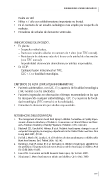Page 614 - Motivos de Consulta en Urgencias Pediátricas
P. 614
Libro_2: Manual 408pag 28/3/11 16:01 Página 589
TRAUMATISMO CRANEOENCEFÁLICO
Podría ser útil:
• Niños < 1 año con cefalohematoma importante no frontal.
• En el contexto de un estudio radiológico más amplio por sospecha de
maltrato.
• Portadores de válvulas de derivación ventricular.
INDICACIONES DE INGRESO.
• En planta:
– Sospecha malos tratos.
– Fracturas craneales aisladas en menores de 2 años (con TAC normal).
– Persistencia de síntomas más de 6 horas en la unidad de observación
(con TAC normal).
– Imposibilidad observación domiciliaria por adultos responsables.
• En UCIP:
– Cualquier lesión intracraneal en TAC.
– GSC < 13 o focalidad neurológica.
CRITERIOS DE ALTA (DAR HOJA INFORMATIVA):
• Paciente asintomático, con GSC 15 y ausencia de focalidad neurológica
(TAC normal si se ha solicitado).
• Pacientes ingresados en observación el tiempo recomendado en los que
ha desaparecido cualquier sintomatología, GSC 15 y ausencia de focali-
dad neurológica (TAC normal si se ha solicitado).
• Garantías de observación por adultos responsables.
REFERENCIAS BIBLIOGRÁFICAS
1. The management of minor closed head injury in children.Committee on Quality Impro-
vement, American Academy of Pediatrics. Commission on Clinical Policies and Rese-
arch, American Academy of Family Physicians. Pediatrics 1999; 104:1407.
2. Blackwell CD, Gorelick M, Holmes JF et al. Pediatric head trauma: changes in use of
computed tomography in emergency departments in the United States over time. Ann
Emerg Med 2007; 49:320.
3. Da Dalt L, Marchi AG, Laudizi L, et al. Predictors of intracranial injuries in children after
blunt head trauma. Eur J Pediatr 2006; 165:142.
4. Dunning J, Daly JP, Lomas JP, et al. Derivation in children’s head injury algorithm for
the prediction of important clinical events decision rule for head injury in children. Arch
Dis Child 2006; 91:885.
5. Evans RW. Concussion and mild traumatic brain injury. Up To Date. 2009.
6. Schutzman S. Minor head injury in infants and children. Up To Date. 2009.
589
TRAUMATISMO CRANEOENCEFÁLICO
Podría ser útil:
• Niños < 1 año con cefalohematoma importante no frontal.
• En el contexto de un estudio radiológico más amplio por sospecha de
maltrato.
• Portadores de válvulas de derivación ventricular.
INDICACIONES DE INGRESO.
• En planta:
– Sospecha malos tratos.
– Fracturas craneales aisladas en menores de 2 años (con TAC normal).
– Persistencia de síntomas más de 6 horas en la unidad de observación
(con TAC normal).
– Imposibilidad observación domiciliaria por adultos responsables.
• En UCIP:
– Cualquier lesión intracraneal en TAC.
– GSC < 13 o focalidad neurológica.
CRITERIOS DE ALTA (DAR HOJA INFORMATIVA):
• Paciente asintomático, con GSC 15 y ausencia de focalidad neurológica
(TAC normal si se ha solicitado).
• Pacientes ingresados en observación el tiempo recomendado en los que
ha desaparecido cualquier sintomatología, GSC 15 y ausencia de focali-
dad neurológica (TAC normal si se ha solicitado).
• Garantías de observación por adultos responsables.
REFERENCIAS BIBLIOGRÁFICAS
1. The management of minor closed head injury in children.Committee on Quality Impro-
vement, American Academy of Pediatrics. Commission on Clinical Policies and Rese-
arch, American Academy of Family Physicians. Pediatrics 1999; 104:1407.
2. Blackwell CD, Gorelick M, Holmes JF et al. Pediatric head trauma: changes in use of
computed tomography in emergency departments in the United States over time. Ann
Emerg Med 2007; 49:320.
3. Da Dalt L, Marchi AG, Laudizi L, et al. Predictors of intracranial injuries in children after
blunt head trauma. Eur J Pediatr 2006; 165:142.
4. Dunning J, Daly JP, Lomas JP, et al. Derivation in children’s head injury algorithm for
the prediction of important clinical events decision rule for head injury in children. Arch
Dis Child 2006; 91:885.
5. Evans RW. Concussion and mild traumatic brain injury. Up To Date. 2009.
6. Schutzman S. Minor head injury in infants and children. Up To Date. 2009.
589


